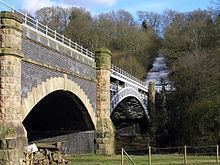The Elan aqueduct crosses Wales and the Midlands of England, running eastwards from the Elan Valley Reservoirs in Mid Wales to Birmingham's Frankley Reservoir, carrying drinking water for Birmingham.
It delivers enormous quantities of water by gravity across the mid-Wales countryside, through north Herefordshire, south Shropshire and into the West Midlands through eleven major river valleys. The aqueduct is 73 miles (117 km) long, down which the water travels at less than two miles per hour, taking one-and-a-half days to get to Birmingham.
Work on the first 13 miles (21 km) of the route from the Elan Valley was started in June 1896 by Birmingham Corporation Water Department. The aqueduct was built in sections by outside contractors, using three types of construction depending on the nature of the terrain it had to cross. "Cut and cover" was essentially a brick lined channel which was manually dug as a trench, then roofed over and concealed underground. Where the route of the aqueduct encountered high ground above the gradient needed to maintain the downward slope, a certain amount of tunnelling was required, using the same type of channel as above. This totalled around 12 miles (19 km), with the longest single length being just over 4 miles (6.4 km). The third construction type was the use of pipelines to cross valleys and rivers where the ground level dropped too steeply for the required hydraulic gradient. The pipeline was continued at the other side of the valley at the same height as the delivery pipe, as the water naturally fills the pipe due to the head of water travelling along behind.
The initial scheme opened in 1906 with two 42in-diameter pipes. Two more pipes of 60in diameter were added between 1919 and 1961.
The engineer for the Elan aqueduct scheme was James Mansergh.
The route is Caban Coch (52.264032°N 3.597665°W / 52.264032; -3.597665) via Elan Valley, Rhayader, Dolau, Knighton, Leintwardine, Downton on the Rock, Ludlow, Knowbury, Cleobury Mortimer, Bewdley and Hagley to Frankley (52.422451°N 2.001329°W / 52.422451; -2.001329).
The aqueduct and its related features are visible at:
River Wye: 52.296442°N 3.503467°W / 52.296442; -3.503467Valve house: 52.291594°N 3.444634°W / 52.291594; -3.444634Nantmel Aqueduct: 52.286113°N 3.416445°W / 52.286113; -3.416445 (Nantmel Aqueduct)Carmel Aqueduct: 52.287612°N 3.383281°W / 52.287612; -3.383281 (Carmel Aqueduct)Bridge over culverted stream: 52.300834°N 3.216593°W / 52.300834; -3.216593Observation tower: 52.303591°N 3.188647°W / 52.303591; -3.188647Bridge over stream: 52.314798°N 3.121883°W / 52.314798; -3.121883Survey tower|52.320521°N 3.107452°W / 52.320521; -3.107452Brynymor: 52.287640°N 3.383070°W / 52.287640; -3.383070Hidden Aqueduct: 52.334666°N 3.068550°W / 52.334666; -3.068550 (Hidden Aqueduct)Valve house: 52.339871°N 3.045829°W / 52.339871; -3.045829Inspection chamber: 52.347854°N 3.004957°W / 52.347854; -3.004957Inspection chamber: 52.348547°N 2.980469°W / 52.348547; -2.980469Graham's Cottage Bridge (River Teme, Leintwardine): 52.347344°N 2.858526°W / 52.347344; -2.858526 (Graham's Cottage Bridge)Downton Bridge (River Teme, Downton): 52.350831°N 2.840863°W / 52.350831; -2.840863 (Downton Bridge)Inspection chamber: 52.354799°N 2.825199°W / 52.354799; -2.825199Valve house: 52.359273°N 2.803600°W / 52.359273; -2.803600Inspection chamber: 52.360114°N 2.796648°W / 52.360114; -2.796648Valve house: 52.360438°N 2.793830°W / 52.360438; -2.793830Deepwood Dingle crossing ("80 or 90 feet high", built by Messrs. Morrison & Mason, of Glasgow.): 52.360697°N 2.789672°W / 52.360697; -2.789672 (Deepwood Dingle crossing)Wheelers Vallets Dingle Crossing: 52.361508°N 2.780470°W / 52.361508; -2.780470 (Wheelers Vallets Dingle Crossing)Teme Bridge (River Teme, Ludlow): 52.359678°N 2.703721°W / 52.359678; -2.703721 (Teme Bridge)Ledwyche Brook: 52.3603172°N 2.6802536°W / 52.3603172; -2.6802536Inspection chamber: 52.363091°N 2.628587°W / 52.363091; -2.628587Bennettsend Bridge (Cumberley Lane/ Colly Brook): 52.365627°N 2.617254°W / 52.365627; -2.617254 (Bennettsend Bridge)Hope Bagot Bridge: 52.364581°N 2.605730°W / 52.364581; -2.605730 (Hope Bagot Bridge)Corn Brook: 52.369394°N 2.581770°W / 52.369394; -2.581770Trig point: 52.366449°N 2.596530°W / 52.366449; -2.596530Valve house: 52.381486°N 2.507248°W / 52.381486; -2.507248Bridge over stream: 52.385448°N 2.492773°W / 52.385448; -2.492773River Rea: 52.387401°N 2.478847°W / 52.387401; -2.478847Mad Brook: 52.393083°N 2.413848°W / 52.393083; -2.413848River Severn: 52.40117°N 2.33145°W / 52.40117; -2.33145siphon: 52.414734°N 2.266107°W / 52.414734; -2.266107siphon: 52.416608°N 2.252064°W / 52.416608; -2.252064siphon: 52.429898°N 2.163124°W / 52.429898; -2.163124siphon: 52.429569°N 2.152842°W / 52.429569; -2.152842Remains of former bridge over Birmingham-Worcester railway line: 52.429318°N 2.142821°W / 52.429318; -2.142821Some crossings over canals and railways have been replaced by buried pipes. The line of the buried aqueduct through woodland is marked by a 20 metres (66 ft) "exclusion zone" from which trees are removed.

